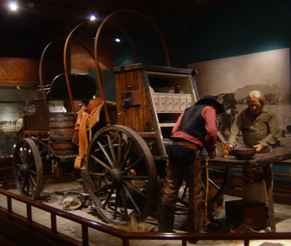| Close by Burbank is Griffith Park and there we found the Gene
Autry Museum of the West. The museum was sponsored by a number of famous
actors from the movie business, among others, but the foremost were Gene
Autry (the 'singing cowboy') and his wife. So, given the proximity of Hollywood
as well, a wing devoted to
the movies was not really surprising. The first display was based on the
movies of Sergio Leone and featured interviews with Clint Eastwood - the
Dollars trilogy! But he also made a lot of films with Charles Bronson, as
well as many others. |  |
 | But there were more
traditional things in the museum like this bronze, of which there must be
thousands, since we have seen it several times - or sculptures very like it. |
| More unusual was this elaborately carved chair. It looked very
good but I can imagine it was very heavy and not very comfortable. It had
been made for a Scottish nobleman who enjoyed visiting the west very much,
and had a pair of these made to stand in the hallway of his Scottish castle. |  |
 | One innovative
display was done with plaster statues and showed many of the things an
Indian family would use day to day. |
| A key element of the westerns were the horses and their saddles.
There were many examples including trick saddles used in rodeos and the
movies for when the horses fell. This was a display saddle used in parades.
It was very elaborately carved and covered with embossed silver
and gold ornamentation. It was made by the top maker Bohlin and is probably worth a
fortune. |  |
 | This was a beautiful
stagecoach which had really been used as such. When the museum first
received it it was a dirty dark brown, and the paintings were only
discovered as they began to restore it for display. |
| The friend we were staying with is a serious equestrian so
we had the finer points of the saddles on display pointed out to us. This
was a side saddle used by women. They require considerable strength in
muscles most of don't use to ride
properly, and a very upright posture. |  |
 | Salesmen used to
travel extensively in the west selling farm machinery. In order to explain
how the machinery worked they carried exquisite working models, of which
these were examples. |
| In the movies the most important wagon on the cattle trail was
the chuck wagon. This was an interesting display showing a chuck wagon in
working mode. All that was missing was the beans and the smell of coffee. |  |
 | There were a number
of costumes from the period. Most like this one were real historical items
donated by local wealthy families. They were also not working clothes but
the 'best' outfits with beautiful ornamentation. |
| It rained a lot in some parts of the west and long oilskin coats
were necessary to keep dry.
This was also the outfit made famous by Clint Eastwood in the Dollar movies. |  |
 | Given that we are in
California it was not surprising to see a number of beautiful Mexican
outfits. In the early part of the century, California consisted of six huge
ranches each owned by a Mexican family, each the size of a country. These
were families of considerable wealth and the outfits amply demonstrated
that... |
| as did the workmanship on this formal jacket. Every bit the
equal of European court dress of the period. |  |
 | These were some of
the outfits from the tum of the century. |
| Of course many of the costumes were from the movies, such as here
with the Lone Ranger and his able sidekick, Tonto. The Lone Ranger was
always shown in black and white, so we never realised that his costume was
really blue. All in all, we were
well impressed with the quality of the museum presentations and enjoyed the
several hours we spent here. |  |
|